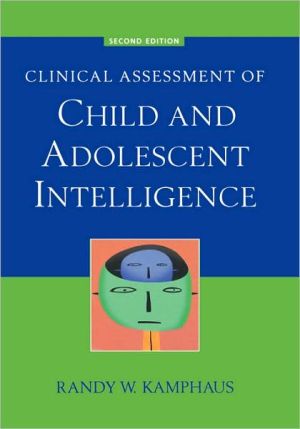Clinical Assessment of Child and Adolescent Intelligence
This volume – now in its second edition – has been completely updated to provide the most comprehensive and accessible handbook of practices and tools for the clinical assessment of child and adolescent intelligence. Designed specifically as a teaching tool, it provides students with an accessible guide to interpretation and applies the same interpretive systems across many tests. It emphasizes the proper interpretation of intelligence tests within the context of a child’s life circumstances...
Search in google:
This volume – now in its second edition – has been completely updated to provide the most comprehensive and accessible handbook of practices and tools for the clinical assessment of child and adolescent intelligence. Designed specifically as a teaching tool, it provides students with an accessible guide to interpretation and applies the same interpretive systems across many tests. It emphasizes the proper interpretation of intelligence tests within the context of a child’s life circumstances and includes several devices to enhance the logical processes of assessment, beginning with test selection and concluding with the reporting of results.In addition, Clinical Assessment of Child and Adolescent Intelligence:- Stresses the importance of the interpretive process over the value of specific tests.- Fosters a deeper understanding of the intelligence construct.- Emphasizes learning by example, using valuable case studies and vignettes designed to provide students with concrete models to emulate. This edition covers all facets of intelligence testing, including detailed explanations of test interpretation, theory, research, and the full-range of testing options for preschoolers through adult clients. New chapters have been introduced on neuropsychological approaches, adolescent and adult intelligence, including coverage of WAIS-III and KAIT, and achievement and intelligence screeners have been added. And although designed primarily as a text for beginning graduate students, the book is also useful as a "refresher" for clinicians who are looking for updated assessment information. Booknews Finding no satisfactory textbook for his graduate psychology course introducing the elementary principles of assessing and diagnosing children and adults, Kamphaus (U. of Georgia) wrote one that applied the same interpretive system across tests. He very specifically identifies it as a teaching tool rather than a resource or reference text, and suggests that it could be used in conjunction with Alam Kaufman's 1990 for a course covering both children and adults. He assumes students have had no previous instruction in assessment. The first edition was published in 1993. Annotation c. Book News, Inc., Portland, OR (booknews.com)
PrefaceAcknowledgmentsSect. 1Psychological FoundationsCh. 1HistoryCh. 2TheoryCh. 3Research FindingsSect. 2Assessment FoundationsCh. 4The Assessment ProcessCh. 5Psychometric Principles and IssuesCh. 6Culture and BiasCh. 7Practice Standards and EthicsSect. 3Assessment MethodsCh. 8The Wechsler Intelligence Scale for Children - Third Edition (WISC-III)Ch. 9Stanford-Binet Fourth EditionCh. 10Kaufman Assessment Battery for Children (K-ABC)Ch. 11Assessment of Adolescent and Adult IntelligenceCh. 12Woodcock-Johnson Tests of Cognitive Ability (W-J)Ch. 13Differential Ability Scales (DAS)Ch. 14Achievement and Intelligence ScreenersCh. 15Infant and Preschool MethodsCh. 16Nonverbal TestsSect. 4Interpretation and ReportingCh. 17Modern Interpretation MethodsCh. 18Report Writing and Oral ReportingCh. 19Neuropsychological Assessment and Intellectual Function in ChildrenCh. 20Mental Retardation and Learning DisabilitiesApp. AIntelligence Test Interpretation ResearchReferencesAuthor IndexSubject Index
\ BooknewsFinding no satisfactory textbook for his graduate psychology course introducing the elementary principles of assessing and diagnosing children and adults, Kamphaus (U. of Georgia) wrote one that applied the same interpretive system across tests. He very specifically identifies it as a teaching tool rather than a resource or reference text, and suggests that it could be used in conjunction with Alam Kaufman's 1990 for a course covering both children and adults. He assumes students have had no previous instruction in assessment. The first edition was published in 1993. Annotation c. Book News, Inc., Portland, OR (booknews.com)\ \
